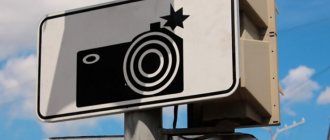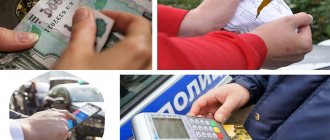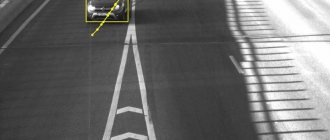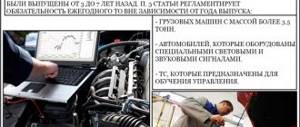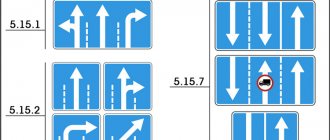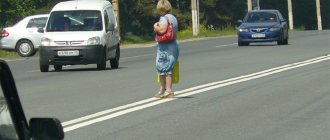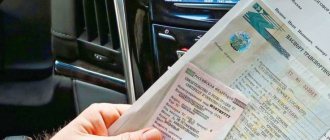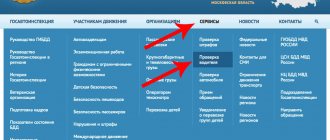The principle of operation of video recording cameras
There are photo and video cameras in every city. Moreover, the installation of cameras in rural areas has long begun. Their popularity can be explained by the fact that they monitor the roads around the clock and record all violations. High-precision instruments allow you to accurately record the license plate number of a vehicle that has violated traffic rules.
The operating principle of the cameras is simple and effective: the video taken of the offender is immediately transferred to TsAFAP. Next, the driver is searched using the State Traffic Inspectorate database. And after some time, the traffic violation violator will receive a receipt with a fine and a photograph of his car at the time of the violation. The drivers themselves call these receipts “letters of happiness.”
TsAFAP is a center for automatic recording of administrative violations of the traffic police.
What does a CCTV camera record?
To date, cameras record the following violations:
- traffic disruption at intersections and pedestrian crossings;
- driving a car without a seat belt fastened;
- over speed;
- parking in the wrong place;
- driving into the oncoming lane;
- section of dividing strips;
- violation of stopping rules.
The entire process of camera operation is automatic. Thus, the influence of a living person who can make mistakes is minimized. In theory, such a system should be fail-safe. Unfortunately, in practice this is not entirely true. There are cases when drivers receive chain letters by mistake.
Typical system errors
The system can also make mistakes. The most common mistakes:
1. Speeding. Cameras are a very high-precision device that can record speeding by 2 km/h or more. But in practice there are also funny cases. For example, a resident of the city of Samara received a fine for speeding. He accelerated his car to 300 km/h. The most interesting thing is that he was driving a Zhiguli. Such fines can be easily challenged. It is much more difficult to challenge a fine for speeding by 10 - 20 km per hour.
2. Wrong car . On the roads you can find cars that are exactly alike. In such cases, the system may confuse the car with a duplicate offender. A completely different driver may receive a fine. To avoid an unfair fine, you need to prove that the driver was in a completely different place at that time. Evidence may include:
- testimony of witnesses;
— information from the DVR;
— video from CCTV cameras.
3. Human factor . Each video from the cameras is first carefully studied by the inspector, and then he sends a receipt with a fine. Since there is a lot of video material and few specialists, unfortunately, errors are possible. The “letter of happiness” may be received by the wrong driver. Such errors are not difficult to challenge. To do this, you need to contact the State Traffic Inspectorate and explain the situation. When re-analyzing the violation, the inspector will be more attentive.
4. Another owner. After selling the car, the new owner is given 10 days to register the car. If he did not do this and violated traffic rules, then the old owner will receive a fine. To appeal a fine, you must provide evidence that the car was actually sold. The following can be used as evidence:
Contract of sale. A document confirming the return of money, confirming the unused compulsory motor liability insurance.
Everyone makes mistakes
Neither photo-video recording systems, nor inspectors issuing fines are blameless. Errors may occur in their work.
The camera may consider the event a violation due to difficult shooting conditions
. There is a known case when the driver of a car, which at that moment was being transported on a tow truck, was fined for speeding. This material was sent by the complex to TsAFAP because the system determined the license plate number of the car and compared it with the data from the speed detector. There was also a high-profile incident involving the intersection of solid markings... with the shadow of a car. The fact is that, first of all, the algorithms for recording violations are configured to identify license plates. They serve as a kind of reference point for determining the vehicle’s position in the traffic lane. The camera only works when it detects a number first in one lane, then in another. The photo, which has been widely discussed, was most likely simply a glitch in choosing the most appropriate one from a sequence of frames between fixations.
There are also more difficult situations when drivers are forced to break the rules
. This is exactly the story that happened quite recently in Khimki near Moscow, where, due to the excessive ingenuity of local authorities, the movement was organized with gross violations of both logic and rules. Drivers did not believe in the experiment of switching a certain section of the road to left-hand traffic and continued to drive along the usual lane, which suddenly turned out to be allocated for buses, which was recorded by a mobile camera. As a result, within a month she issued tens of thousands of fines for violations, without which people simply could not drive up to their own homes.
For such cases, the work of an inspector is necessary, who will identify the error and will not fine the unlucky driver. The fact that in the listed cases fines were nevertheless issued is not so much a problem for the camera as for the inspectors who made the decision
. It was they who had to determine that the drivers, as well as the offense itself, were not at fault in such cases.
However, inspectors also make mistakes. This is most often due to their work overload. The probability of error in such cases increases; we must not forget about the “human factor”. However, those who believe that they were fined without guilt always have the opportunity to appeal the decision.
Deadline for appealing a fine
In accordance with Art. 30 clause 3 of the Code of Administrative Offenses, the driver is given 10 days so that he can challenge the fine for violating traffic rules. Time is counted from the moment the “letter of happiness” is received. You can find out about the presence of a fine even earlier. To do this, you need to go to the traffic police website or the website of the Unified Portal of State Services.
If for some reason the driver missed the time to appeal the fine, then you need to send a petition to the Traffic Police to restore the deadline.
There is no filing fee for appealing administrative fines.
What to do if you receive a fine that was not notified
Timely paid fines for the driver provide a 50% discount. But, as practice shows, notifications do not always arrive. Let's look at options to solve the problem if the notification was not delivered.
Check whether the notification really did not arrive
To check, you need to visit your personal account of the government services portal through the website or mobile application and make sure that there are no notifications in the database. It is also necessary to check the mailbox at the place of registration of residence to make sure that there are no notices about the need to receive a registered letter.
Reinstate the deadline for appeal
When the notification was not sent at all, the driver has the right to appeal the decision based on a petition. You can appeal the decision within ten days after receiving it. In other cases, the period for appeal may be restored by a judge or official who has the appropriate authority.
Submit a request to extend the payment period with a discount
According to the general rules, the driver has the opportunity to pay the fine with a 50% discount during the first 20 days from the date of receipt of the decision. But in 2021, it became possible to restore the deadline for paying fines at a discount if the car owner received the notification late or did not receive it at all. To do this, it is necessary to draw up a petition in electronic or written form and send it to the government body that issued the decision - the court or the traffic police department.
Important! The petition can be submitted during a personal visit or sent by registered mail with a list of the contents and a receipt.
Drawing up a complaint to appeal a decision
You can make a complaint in free form. There is no set form for this type of document. But, despite the free form, the complaint must contain a number of mandatory elements. You must specify:
1 Full name and position of the person to whom the complaint is addressed.
2 Full name and contact details of the applicant.
3 Date and number of the fine.
4 Brief description of the situation.
5 Arguments refuting the facts due to which the decision was made.
6 Request to cancel the decision.
7 List of additional documents and evidence. For example:
A copy of the resolution. Photo and video materials. Documents that will confirm that the driver is correct.
8 Date and signature.
Not just for yourself
Yes, the process of appealing a fine is not simple and long
. However, it is necessary to do this. Restoring justice is already a sufficient goal to go through all the necessary authorities. But there are other reasons to file a complaint.
The point is that they are all analyzed. Based on the results of consideration of protests, adjustments are made to the work of inspectors, who make decisions based on data received from photo-video recording systems. And, more importantly, decisions are made to change camera algorithms.
In our practice, there have been cases when the analysis of incoming violations led to changes in the organization of traffic
. For example, the stationary complex began to record violations related to crossing markings en masse, and before this, such a large number of violations had never happened on this section of the road. An analysis was carried out, and it turned out that during the repair of the road, new markings were applied to it, changing the usual traffic pattern. After analyzing the situation, the company received a request from the traffic police with a requirement to adjust the settings for recording violations with this camera. Another incident involved a large number of traffic lane sign violations. As a result of the analysis of the reasons forcing drivers to break the rules, the traffic organization was changed, eliminating unnecessary restrictions and making it more convenient for motorists.
Not long ago, in a similar situation, the traffic pattern at the intersection of Vologodsky Proezd and Altufevskoye Highway in Moscow was changed. The reason for these changes was precisely the complaints of drivers about unreasonable restrictions
.
These are certainly not the only examples of how motorists’ fight for their rights helps restore justice. An equally important result is the reconfiguration of cameras, the elimination of signs or markings that do not regulate traffic, but interfere with it.
Traffic cameras simply record an event that is classified as a violation
. The decision that he should be punished is made by the inspector, who, as we know, is obliged to consider all the circumstances related to the sin that the driver committed. If this does not happen, then the protest will help not only the unjustly injured. It can prevent injustice against other motorists and even make driving on the road easier and more comfortable.
Consequences of failure to pay a fine
The biggest mistake drivers make is ignoring a fine. In accordance with Art. 32 clause 2 of the Code of Administrative Offenses, the violator is given 60 days to pay the fine. The fine must be paid or appealed. In any case, this issue needs to be resolved. If the allotted time to pay the fine has expired, and the driver continues to do nothing, then TsAFAP employees draw up a second resolution and send it to the bailiffs. For the offender, this may mean:
Doubling the amount of the fine. 50 hours community service. Restriction on leaving the country.
Inaction is punishable. Even if the driver is 100% right, but continues to ignore the fine, then it will be very difficult to change the situation in his favor.
Attention!
Due to frequent changes in the legislation of the Russian Federation, the information on the site may be out of date. Each case is unique in its own way. Basic information may not help solve your problem. Therefore, contact our lawyer for a free consultation!
